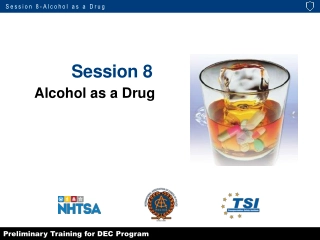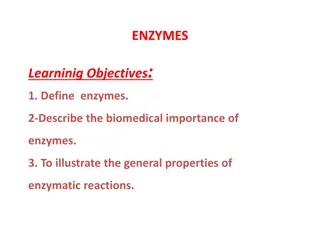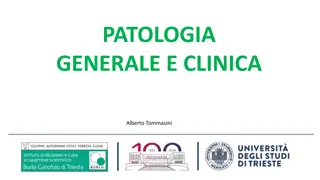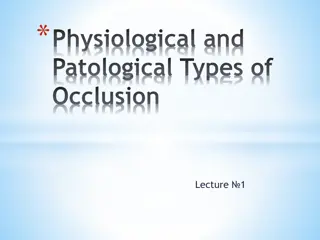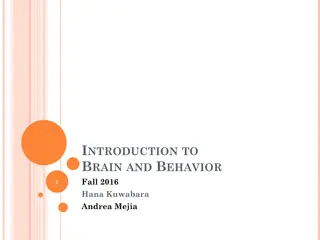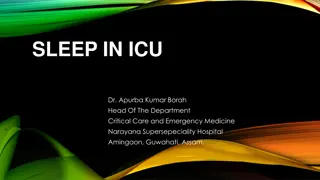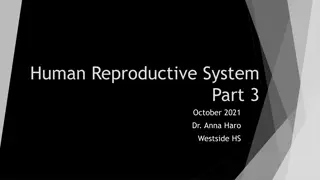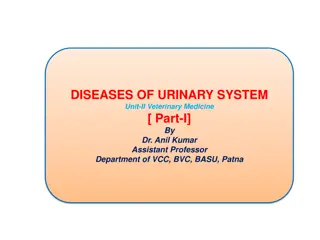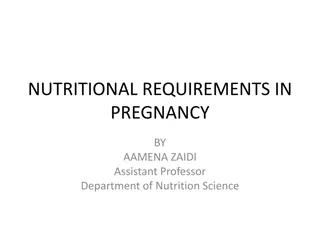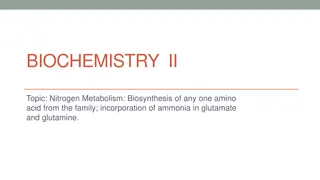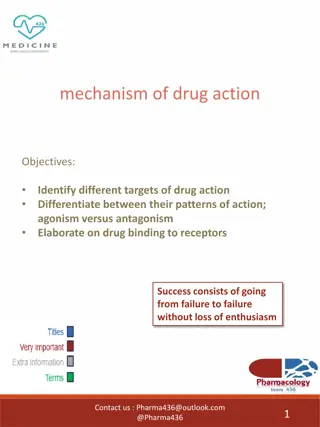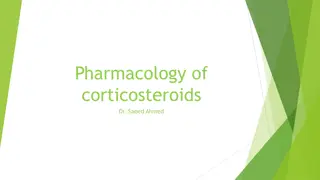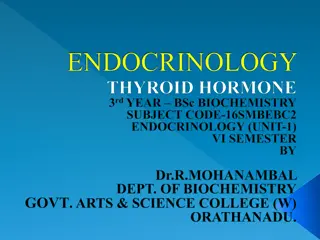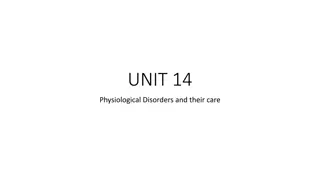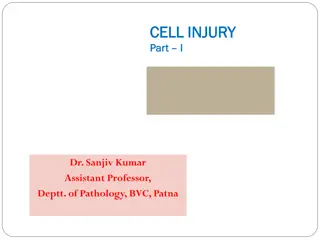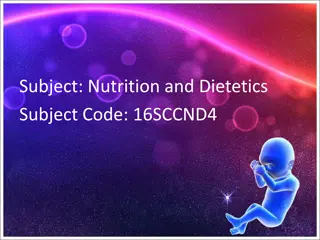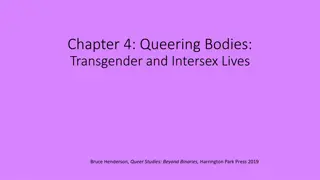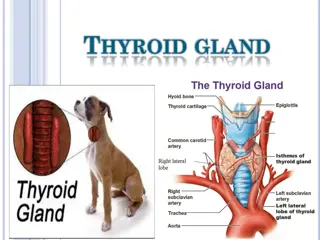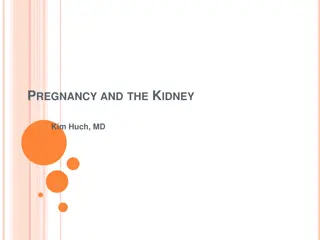Alcohol as a Drug
Preliminary training for the DEC program, covering an overview of alcohol, common types of alcohols, physiological processes of absorption, distribution, and elimination in the body, and dose-response relationships.
1 views • 32 slides
Understanding Heterostyly and Physiological Disorders in Brinjal
Heterostyly in brinjal involves four types of flowers with varying styles impacting fruit setting, while physiological disorders like poor fruit set, calyx withering, and freezing injury can affect the crop's productivity. Controlling measures for each disorder are discussed to help manage these iss
0 views • 10 slides
Understanding Enzymes: Importance and Clinical Applications
Enzymes are vital proteins that speed up chemical reactions without being consumed, playing a crucial role in various physiological processes. They require cofactors for optimal function, and their levels in blood can indicate tissue damage or disease. Learning about enzymes is essential for underst
6 views • 25 slides
Hematopoiesis: Processes and Niches in the Human Body
Hematopoiesis, the process of daily blood cell production, involves maintaining the physiological balance of circulating blood cells. It includes the generation of billions of erythrocytes, platelets, and leukocytes to meet the body's needs. The location of hematopoiesis changes throughout human lif
4 views • 69 slides
Understanding Pulmonary Circulation and V/Q Ratio in Respiratory Physiology
Explore the high-pressure and low-pressure circulations supplying the lungs, the concept of physiological shunt in pulmonary circulation, different lung zones based on blood flow, V/Q ratio and its clinical significance, and abnormal V/Q ratio patterns. Delve into the role of pulmonary circulations
11 views • 28 slides
Understanding Physiological and Pathological Types of Occlusion
This lecture discusses the physiological types of occlusion, focusing on facial and jaw signs to determine correct harmonious occlusion. It explains characteristics of orthognathic bite, straight bite, physiological biprognathism, and opisthognathic bite, highlighting key features such as tooth alig
1 views • 34 slides
Understanding the Brain and Behavior in Fall 2016
This content delves into the intricacies of the brain and behavior, covering topics such as the organization of the brain, the nervous system, brain stem functions, disorders of the cerebellum, and the forebrain components. It provides a detailed exploration of the hindbrain and midbrain structures,
0 views • 30 slides
Understanding Sleep Patterns and Architecture in the ICU Setting
Sleep in the ICU is crucial for physiological rest and emotional well-being, but it is often disrupted due to various factors. Normal sleep architecture consists of REM and Non-REM sleep cycles, each vital for different restorative processes. Non-REM sleep has three stages, including deep sleep impo
0 views • 25 slides
Understanding the Male Reproductive System Physiology
The male reproductive system facilitates spermatogenesis, hormone production, and the physiological processes essential for ejaculation and erection. Sperm cells mature in the epididymis before passing through the vas deferens to reach the seminal vesicle, where they are nourished with nutrient-rich
0 views • 11 slides
Understanding Urinary System Function in Veterinary Medicine
The urinary system in veterinary medicine involves the anatomy and physiological functions of maintaining body fluid composition and volume. Key processes like urine production, filtration, reabsorption, and regulation through nephrons play vital roles in maintaining overall health. This article cov
1 views • 14 slides
Understanding Nutritional Requirements in Pregnancy by Aamena Zaidi
Adequate nutrition before and during pregnancy is crucial for long-term maternal and fetal health. Maternal health is influenced by genetic, social, and economic factors, impacting physiological adaptations for better nutrient utilization. Physiological changes in pregnancy include increased total p
1 views • 41 slides
Understanding Trauma in Pregnancy and Intimate Partner Violence
Pregnancy introduces unique challenges in trauma care due to anatomical and physiological changes. Major physiological alterations impact injury patterns and responses, necessitating specialized management strategies. Blunt trauma incidents during pregnancy, including motor vehicle crashes and falls
1 views • 33 slides
Understanding Histamine and Antihistaminics: A Comprehensive Overview
Histamine is a vital autacoid synthesized and stored in mast cells, playing a key role in various physiological processes and allergic reactions. This article delves into its synthesis, storage, release, and receptors like H1, H2, and H3, along with the pharmacology of antihistamines. Explore the in
0 views • 24 slides
Importance of Transport System in Animals for Oxygen Supply
Animals require a transport system to meet tissue oxygen demands efficiently. The size limit for oxygen diffusion alone is around 1 mm due to the proportional increase in radius and diffusion properties. Blood is crucial for transporting oxygen, nutrients, waste products, cells, and heat, as well as
0 views • 17 slides
Understanding the Importance of Phospholipids in Physiology
This educational material delves into the significance of phospholipids in physiological processes. Topics covered include the structure and functions of phospholipids, their role in membranes, signaling mechanisms, and non-membrane functions. The content also explores lipid compounds as a heterogen
0 views • 25 slides
Understanding Nitrogen Metabolism: Amino Acid Biosynthesis and Ammonia Incorporation
Nitrogen metabolism is crucial in the biosynthesis of amino acids such as glutamate and glutamine, incorporating ammonia for various physiological processes. Ammonia is efficiently transported and stored using compounds like alanine and glutamate, playing a key role in the urea cycle. Glutamate, a v
0 views • 22 slides
Understanding the Electrical Activities of the Heart - An Overview
The electrocardiogram (ECG) is a result of intricate physiological and technological processes involving transmembrane ionic currents, cardiac activation sequences, and electrode connections. The cardiac conduction system consists of various components like the sinoatrial node, atrioventricular node
0 views • 39 slides
Understanding Drug Action Mechanisms and Receptor Targets
Pharmacodynamics involves studying the effects of drugs on biochemical and physiological levels, focusing on drug actions through receptor-mediated and non-receptor mechanisms. The interaction between drugs and targets like proteins and enzymes impacts cellular functions. Different binding forces, s
0 views • 9 slides
Understanding Corticosteroids: Pharmacology and Effects
Corticosteroids, including glucocorticoids and mineralocorticoids, play vital roles in intermediary metabolism, immune responses, and inflammation regulation. They bind to specific receptors in the cell, entering the nucleus to influence gene transcription and protein production. These hormones have
14 views • 32 slides
Understanding Plant Growth Regulators: Phytohormones and Their Functions
Plant growth regulators, also known as phytohormones, are organic compounds produced naturally in plants to control growth and physiological functions. They include auxins, gibberellins, cytokinins, ethylene, growth regulators, and inhibitors. Auxins, for example, promote growth along the plant's lo
2 views • 28 slides
Understanding Communication Barriers: Insights from Dr. Nadeem Khan
Communication barriers can hinder the effectiveness of communication processes. Psychological barriers, physiological barriers, physical barriers, and attitudinal barriers all play a role in how messages are received and understood. Recognizing and addressing these barriers is essential for improvin
0 views • 12 slides
Amino Acid: Structure and Classification Overview
Amino acids are essential building blocks of proteins, with only 20 out of the 300 occurring in nature being used for protein synthesis. The structure of amino acids consists of four groups attached to a central carbon atom. At physiological pH, these groups can ionize, forming zwitterions. Amino ac
0 views • 24 slides
Understanding Thyroid Hormones and Their Role in Metabolism
Thyroid hormones, including triiodothyronine (T3) and thyroxine (T4), are essential for regulating metabolism, growth, development, body temperature, and heart rate. They are tyrosine-based hormones produced by the thyroid gland, requiring iodine for synthesis. T3 affects various physiological proce
2 views • 17 slides
Understanding Physiological Disorders: Rheumatoid Arthritis and Coronary Heart Disease
Explore the causes, effects, and treatment of Rheumatoid Arthritis and Coronary Heart Disease as part of investigating physiological disorders. Delve into the impact on the physical, mental, and emotional health of service users. Gain insights into the diagnosis, treatment, and support necessary for
0 views • 27 slides
Understanding Cell Injury and Adaptation in Pathology
Rudolph Virchow's concept of disease starting at the cellular level highlights how cells constantly face challenges in maintaining homeostasis. The plasma membrane acts as a barrier against external stressors, but when cells face excessive physiological stresses or pathological stimuli, they adapt o
0 views • 16 slides
Role of Major Physiological Anions in the Human Body
Physiological anions such as chlorides, sulphates, bicarbonate, phosphates, and electrolytes play essential roles in maintaining various functions within the body. Chloride ions help in osmotic balance, charge balance, and acid-base balance. Sulphates are important for detoxification mechanisms and
0 views • 11 slides
The Biosynthesis and Role of Salicylic Acid in Plants
Salicylic acid (SA), a phenolic derivative widely present in plants, plays a crucial role as a regulator in various physiological and biochemical processes. Originally isolated from willow trees, SA is synthesized through the shikimate pathway via metabolic routes involving enzymes like PAL and BA2H
0 views • 10 slides
Understanding Ageing and its Impact on Health and Social Well-being
Explore the physiological, social, and emotional aspects of ageing in healthcare. Learn about the ageing process, demographic changes, physiological effects, physical diseases, and social impacts on older individuals. Gain insights into the holistic needs of older people and the challenges they face
0 views • 86 slides
Understanding Parasitism in Veterinary Medicine
Parasites can cause significant harm to animals by interfering with normal physiological processes. They can be ectoparasites (external) like mites and ticks, or endoparasites (internal) such as roundworms and hookworms. Diagnosis of parasitism is crucial for effective treatment, with common species
0 views • 27 slides
Methods and Devices for Detection of Deception
Various methods and devices are used for the detection of deception, including physiological responses recording, drug usage, hypnotism, observation, scientific interrogation, and confession. Deceptive behaviors manifest in verbal responses, posture changes, gestures, movements, and facial expressio
0 views • 20 slides
Understanding Programs and Processes in Operating Systems
Exploring the fundamental concepts of programs and processes in operating systems, this content delves into the definitions of programs and processes, the relationship between them, the components of a program, what is added by a process, and how processes are created. The role of DLLs, mapped files
0 views • 22 slides
Understanding Renal Clearance and its Physiological Mechanisms
This content delves into the concept of renal clearance, exploring its relation to lipophilicity and mechanisms such as glomerular filtration, tubular secretion, and reabsorption. The processes occurring at the nephron level and the vascularization scheme are detailed, along with a breakdown of phys
0 views • 31 slides
Understanding the Biochemistry of Insect Hemolymph
Insect hemolymph, also known as blood, plays a crucial role in maintaining the tissues throughout the body. It consists of plasma containing hemocytes suspended in a fluid rich in various chemicals. The pH of the hemolymph ranges between 6.4 and 6.8, with variations in volume across different insect
0 views • 9 slides
Physiological Changes During Pregnancy: A Detailed Overview
Explanation of physiological changes in pregnancy including genital, breast, blood volume, and composition, as well as skin changes. Details on changes in the uterus, breast size, blood circulation, hormones, gastrointestinal motility, skin pigmentation, and more are covered.
0 views • 51 slides
Study on Physiological Functions Using Chronophotographic Gun
Étienne-Jules Marey's pioneering work in time-resolved photography for studying physiology inspires a proposal for a quantitative analysis of physiological functions using similar techniques. The project involves analyzing videos to study postures, locomotion, and other important physiological para
0 views • 7 slides
Understanding Bodies: Beyond Physiological Container to Social Construct
Bodies are viewed through two contrasting lenses - materialist as a physiological container and social as a construct filled with possibilities. Bruce Henderson's exploration in "Queer Studies: Beyond Binaries" delves into the complexities of transgender and intersex lives, challenging traditional p
0 views • 21 slides
Understanding the Thyroid Gland: Structure, Hormones, and Function
The thyroid gland, a butterfly-shaped structure located on the ventral surface of the trachea, secretes hormones essential for regulating metabolic rate, growth, and development. It produces hormones like Tetraiodothyronine T4, Triiodothyronine T3, and Calcitonin, which play crucial roles in maintai
0 views • 21 slides
Pregnancy and the Kidney: Physiological Changes and Considerations for Chronic Kidney Disease
GB, a 28-year-old woman with a history of FSGS, seeks advice on pregnancy. Physiological changes in pregnancy affect renal function, including increased renal flow and volume, ureteral dilation, and systemic vasodilation. Renal hemodynamics peak in the first trimester without causing kidney damage.
0 views • 36 slides
Satellite Applications in Estimating Earth's Surface Energy Budget
Satellites play a crucial role in estimating the Surface Energy Budget (SEB) by providing data on various components such as Surface Radiation Budget and Surface Turbulent Fluxes. The SEB includes factors like net radiation flux, sensible and latent heat fluxes, and subsurface heat transfer. Satelli
0 views • 38 slides
Understanding Stress Response and its Impact on the Body
Stressful situations trigger a cascade of physiological changes known as the "fight-or-flight" response. The body's hormonal and physiological reactions help in coping with threats, but overreactions to non-life-threatening stressors can occur. The brain's command center, the hypothalamus, communica
0 views • 10 slides
